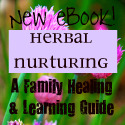Welcome to Domestic by Design! If this is your first time here, please start here.
———————————————————————————————————————-
If you’ve missed steps 1-9 in our series, you can easily find them here!
Milk is one of the most consumed foods in America. Whole milk, 2%, skim, organic, rBGH-free, ultra-pastuerized…so which is best to drink? Today, we’ll dive into the milk issue and come out with an understanding of why I believe raw milk is the best choice of milk to consume as part of a nourishing diet.
First, let’s define the terms we commonly see on milk products.
Pastuerization is the process in which milk is heated at 145 degrees for 30 minutes or 169 degrees for 15 seconds and then quickly cooled to 39 degrees. The latter is referred to as HTST (High Temperature/Short Time) and is the required method by government regulations for milk pastuerized by commercial dairies. For ultra-pasteurized products, milk is heated to 169-285 degrees while being forced through metal plates. Then is it quickly cooled to 39 degrees.
Homogonization is the process in which When the fat globules broken down to mix with the rest of the milk making a uniform substance that is supposedly a more appealing texture to the consumer. You won’t find cream on the top. For a more scientific explanation, read about it here. (http://en.wikipedia.org/wiki/Milk#Processing)
rBGH or rBST. Recombinant bovine growth hormone is given to cows with the purpose of increasing their milk supply. It has been stated that in 1930, long before the hormone was introduced, the average dairy cow gave 1.5 gallons of milk/day. In 2003, it was up to 6 gallons a day.
Organic. While the living conditions and treatment of animals might be better than other brands (more on this later), this milk is often ultra-pastuerized.
Grass-Fed. It’s sort of funny (and sad) that this even needs to be put on labels. Cows are herbivores, they graze on grass and hay. Cows that are allowed to eat what they were designed to eat produce milk that is high in healthy fats and is chock full of vitamins and minerals. However, most commercial dairy farms feed their animals waste by-products and GMO grains, among other things.
Raw. This is milk that has not been pasteurized or homogenized.
Why do these things matter?
Pasteurization obliterates beneficial bacteria, enzymes, and proteins, and makes mineral absorption difficult. Homogonization is a totally unnatural process, damaging the God-given fats in the milk.
“Pasteurized milk has up to a 66 percent loss of vitamins A, D and E. Vitamin C loss usually exceeds 50 percent. Heat affects water soluble vitamins and can make them 38 percent to 80 percent less effective. Vitamins B6 and B12 are completely destroyed during pasteurization. Pasteurization also destroys beneficial enzymes, antibodies and hormones. Pasteurization destroys lipase (an enzyme that breaks down fat), which impairs fat metabolism and the ability to properly absorb fat soluble vitamins A and D. (The dairy industry is aware of the diminished vitamin D content in commercial milk, so they fortify it with a form of this vitamin.)”
And the growth hormones…
They sound good for dairy farmers who want to make money, but there are consequences! Simply put, the cows given growth hormones produce more milk than those to whom it is not administered. These hormones, however, lead to big problems.
Cows are 75% more likely to develop mastitis, which means antibiotics! (Small farmers can deal with mastitis without the use of antibiotics, but think about what you would do if you have 200 cows, with many or most of whom come down with it?)
“In 1991, a report on Monsanto’s BGH test herd at the University of Vermont found the same kinds of problems identified by the FDA, plus an alarming number of dead and deformed calves born to cows treated with BGH. Other problems include reproductive difficulties, increased need for antibiotics, digestive problems, enlarged hocks and lesions, and foot problems.”
“According to the Humane Farming Association, The FDA admits that BGH injections increase sickness and drug use in dairy cows. Consumer’s Union reports that because of increased udder infections, it is more likely that milk from treated cows will be of lower quality–containing more pus and bacteria–than milk from untreated cows.”
History speaks loudly…
Pastuerization was introduced in the late 1880s due to diseases cropping up from poor conditions where the cattle were kept. Children were dying and people were getting sick. The cause was traced back to milk from confinement farms in which the cattle were literally knee deep in manure, and the milk was being contaminated. These farmers realized that by pastuerizing the milk, they didn’t need to change the conditions because the bad bacteria would simply be killed during the pastuerization process.
Personal responsibility and accountability for dairy farmers diminished. They could have nasty conditions and sick cows, but since pasteurization kills MOST of the bad bacteria, they could get away with it. Driven by money, they found a way to distribute “clean” milk in order to continue making a profit. Soon after, people began believing that pasteurized milk was better for you. Sadly, this is still happening today.
These reasons (and more) are why I do not trust any milk that is sold in the grocery store.
So, back to raw milk…
Non-homogonized, unpasteurized milk has all of its nutrients readily available for absorption such as vitamins A, D, B6, and B12. Calcium and CLA, conjugated linoleic acid (essentially fatty acid occurring naturally in grass-fed milk and beef) are abundant.
Raw milk is complete source of protein. It is also loaded with beneficial enzymes that aid in digestion and protect against pathogens. You know how you hear about yogurt being full of “good bacteria”? Well, raw milk, though not containing as much, is naturally full of it, too! It is non-existent in pasteurized milk.
None of these beneficial nutrients are destroyed because the processing of raw milk is minimal. The animal is milked, the milk is chilled then bottled. End of story. It’s unadulterated.
Not only that, but since none of its enzymes are destroyed, people who are typically lactose intolerant can drink cow’s milk without a problem! These enzymes are what aid in digestion.
This is why I believe raw milk should be a part of a nourishing diet and is a part of my family’s.
Is it safe?
Often, when the topic of raw milk is brought up, its safety is called into question. And for good reason, since there have been people in who have become sick from it. This is when it is necessary to think rationally, setting aside presuppositions, and exercise discernment.
Just because someone (or several people) have been sick from raw milk before does not mean that all raw milk is unsafe. What about all the beef recalls over the years? Does that mean we should avoid all ground beef? No. To think so would be irrational, just like it’s irrational to fear drinking raw milk. Don’t get me wrong, there is always risk involved. But this is true with any food you purchase and consume. It has all gone through processing.
By learning about raw milk, knowing what questions to ask, and buying it from a safe source, it is possible to drink raw milk without reservation. We and numerous other families do daily.
Where do I find safe sources for raw milk?
There is so much to say on the issue of raw milk and about how to find a safe source, but not enough space. So, I’ve written an ebook that goes into more depth for those of you who are interested but maybe hesitant due either to a lack of knowledge about raw milk or fear. It is also great to give to someone else who might have questions or interest.
In the book, I go into more depth about the processing of milk, question the status quo of pasteurization, walk you through the steps of how to interview a farmer when looking for raw milk, where to find sources for raw milk, and much, much more. You can purchase the book here.
What About the Cost?
Raw milk can be expensive. We currently pay a little over $6/gallon of milk. I realize that in some places, it’s even more expensive than that I know of a blogger in Canada who pays $18/gallon!). We believe it’s worth our money to consume it, so I’ve made adjustments in our food budget by choosing to buy less of something else in order to accommodate raw milk.
The point is not to communicate to you that are a bad mom if you choose to give your family store-bought milk. The point is to equip you so that you can make the best decision for your family.
Do I believe raw milk is superior in nutritional quality? Yes. Do I believe that if you consume store-bought milk you could potentially be harming your health? Yes. But do I take the time to investigate the refrigerators of my friends houses or look down on someone who doesn’t drink raw milk? NO. So if you choose not to drink raw milk, don’t worry about what I might think of you if I find out.
Remember that my goal in this series is to inform and encourage you toward taking responsibility for your own health decisions and to think about what you’re putting into your bodies and those of your family. I’ll discuss the money aspect to all of these real food changes at the end of our series.


















